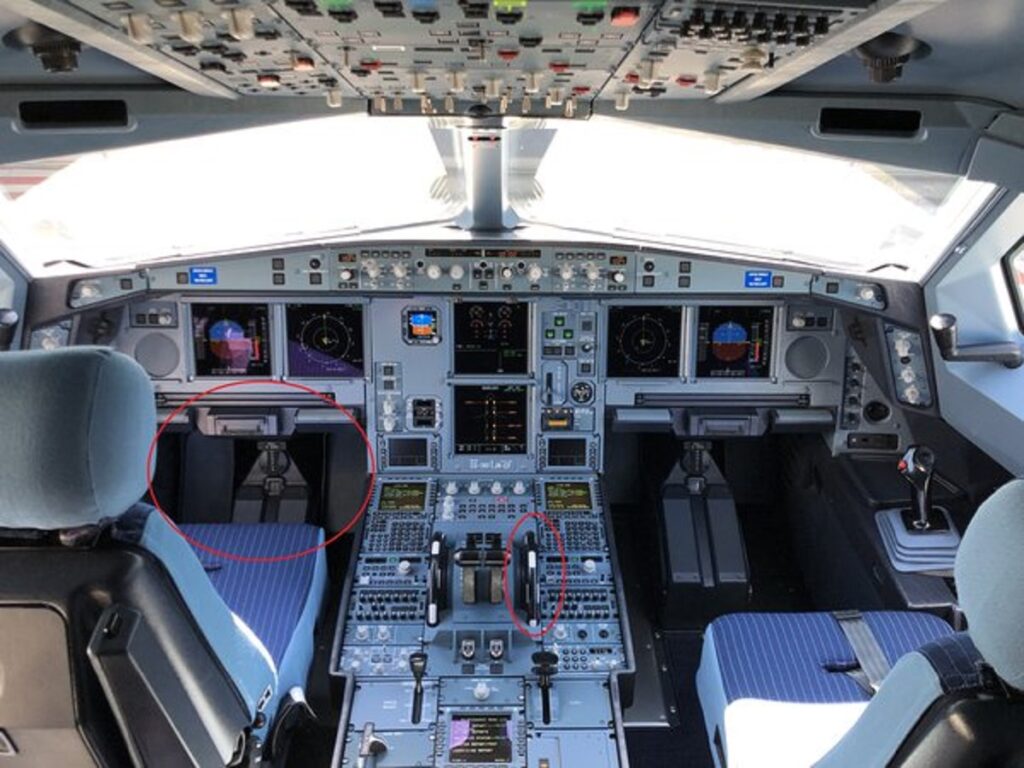The Airbus A320, A330 and A340 has a mechanically controlled rudder and a Trimmable horizontal stabilizer (THS). The rudder can be controlled with the pedals in the cockpit and the THS by the trim wheels on the throttle quadrant. These controls do not require any electrical input or computers to work. As long as the aircraft has a working hydraulic system, they should work just fine. The rudders can be used for roll control and the trim can be used for the pitch control. Airbus calls it the Mechanical Backup. I have flown with mechanical back up in the simulator and I can assure you that it gives you adequate control, at least for a forced landing.
The rudder pedals and the trim wheels can be used to control the aircraft in a total electrical failure (picture: An A330 cockpit).
In a modern airliner, a total electrical failure is highly unlikely because the electrical system of the aircraft is extremely redundant. For example, the A320 has:
- Two independent engine driven AC electrical generators.
- An APU driven generator which is capable of powering the entire aircraft.
- An emergency generator which is run by the Ram air turbine (RAT) which is capable of powering all the essential aircraft systems.
- The batteries.
So, for a total electrical failure to happen, all of these layers of protection should fail, which is highly improbable. As for the computers. There are multiple computers and the aircraft can be controlled with just one of them active. The only downside is that it will most certainly degrade the flight control laws.
As for the newer Airbuses, for instance in the A350, there is no provision for manual backup. If there is a total electrical failure, the aircraft cannot be controlled (with normal flight controls) as there are no mechanical controls. But it has extra layers of protection. The A350 has:
- Four independent engine driven AC electrical generators.
- One APU generator.
- An emergency generator run by the RAT.
- Four batteries with two of them specifically built in for emergency DC power generation.
Yes, that is a lot of backup. But that is not it. As the flight controls are critical, Airbus put in another safeguard in the A350 and that is something called an Electrical Backup System (EBS) designed just for the flight controls. It functions in the event:
- All the flight control computers fail (there are a total of six in the aircraft).
- The power supply for the flight control computers fail.
The EBS is completely independent. It consists of its own generator that is run by the yellow hydraulic system of the aircraft. This generator is then used to power up the backup control module (a simpler control computer) which actuates the control surfaces. The EBS actuates the following controls:
- The elevators (pitch control).
- The inboard ailerons (roll control)
- The rudder (yaw control).
When the EBS is active, the control laws are degraded to direct law and the normal Airbus protections are lost. But it gives the pilot more than enough control to keep the aircraft in the air. It is a way better backup system than the mechanical backup found in the previous Airbus aircraft models.
The A350 EBS architecture.
Author – Anas Maaz ( Airline Pilot )






